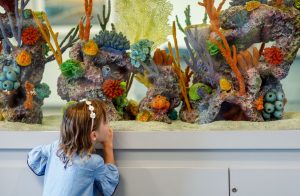Healthy vision is essential for the development of every child. A weak vision or eye problems will affect a child’s learning ability and personality, in addition to changing his/her ability to tackle school work. The next time you take your child for a health check-up, make sure you include eye tests too.
Here are a few common eye problems in children:
AMBLYOPIA
Amblyopia is the failure to develop normal visual potential on a cognitive level, due to ocular misalignment (strabismus), refractive error, or visual deprivation (congenital cataract, ptosis, and retinal pathology). It effects nearly 4% of the pediatric population and should ideally be treated before the age of 8, after which it can cause irreversible visual loss in the affected eye.
STRABISMUS
Strabismus is a condition in which the eyes do not properly align with each other when looking at an object. Strabismus may be treated with refractive correction in some cases, or by timely surgical intervention. If detected early, binocularity can be restored
REFRACTIVE ERRORS
When the shape of the eye doesn’t refract the light properly, images will appear blurred. Refractive errors can also cause amblyopia. Common refractive errors include:
- Nearsightedness: Also called myopia, nearsightedness is poor distance vision when you can’t see things that are at a distance.
- Farsightedness: When you have trouble seeing close objects, it’s called farsightedness or hyperopia.
- Astigmatism: This causes an imperfect curvature of the front surface of the eye, which makes the objects appear either ‘stretched’ or ‘shrunk.’
- Anisometropia
Prevention is better than cure, so it’s best to catch problems when they are in their nascent stage and prevent eye problems before they happen. Here are a few essential tips for helping your child develop and maintain healthy vision:
WATCH FOR WARNING SIGNS
A child may not recognize eye problems, so look out for signs of vision impairment. Call our office right away if your child is squinting, rubbing eyes excessively, closing one eye, or tilting their head while reading or watching TV, sitting too close to electronic screens or holding books closer than usual, etc. If your child has a vision issue in only one eye, it may be difficult to detect unless you test each eye separately.
ENCOURAGE PROPER EYE CARE
Help your little one develop good eye care habits at a young age. Teach them to wash their hands often and avoid touching or rubbing their eyes. Wearing protective eyewear, especially while playing sports, working with tools, and swimming, is another good habit.
AVOID DIGITAL EYE STRAIN
Children have started using digital screens as much as adults. Digital eye strain can cause a plethora of eye problems. Try and delay your child’s exposure to digital screens or keep them restricted to educational purposes. Try and limit the use of digital screens, especially at night.
SCHEDULE REGULAR EYE EXAMS
You should take your child to see an eye doctor regularly even if they don’t seem to have eye problems or their school conducts vision screenings. In many cases, symptoms of eye disease may not be obvious. New technology (photoscreeners) have greatly improved our ability for early detection. If your child has failed a vision screening, please take the findings seriously
UPGRADE THEIR DIET
Ensure that your kid is eating a balanced diet. Nutrition is crucial for eye health, especially vitamins A, C and E, zinc, lutein, zeaxanthin, and omega-3 fatty acids.
A balanced diet boosts vision development, as well as preventing obesity and obesity-related diseases such as diabetes, which can affect eye health.
SEND THEM OUTDOORS
Playing outdoors instead of being stuck to the TV or computer can help your child’s vision in more than one way. First, it reduces near point stress and digital eye strain. Second, exposure to differing proximities and colors in natural light helps kids develop and exercise their visual senses. Sunlight exposure has also been shown to decrease the risk for myopia progression in several studies.
Just make sure they wear sunglasses with 99-100% UV protection outside since excessive UV exposure can lead to eye damage.
GET PROTECTIVE EYE WEAR
Sports are fun, but they can also expose your child to all manner of injuries, especially eye injury. Please encourage them to wear protective goggles or helmet-mounted face shields during contact sports, as well as swimming goggles to protect against chlorine and germs when they’re in the pool. If your child has other hobbies such as wood shop, get the right eyewear to keep them safe.
Encourage Proper Rest – Your child may spend most of their time hitting the books or working on the computer when the school year gets underway, but they need proper rest too. For healthy eyes, please encourage them to sleep well, step outdoors for fresh air and exercise, take frequent breaks while reading and using digital screens, and blink often. If their eyes get enough rest, there’s a lower risk of eye strain, dry eye, blurred vision, headaches, backaches, and more.
Pediatric Eye Consultants of North Florida is here for your child’s vision needs. Open 7 AM – 3:30 PM, Monday through Friday, Dr Duss, and Dr Armanious, along with our entire medical and administrative team are here to answer any questions you may have.

